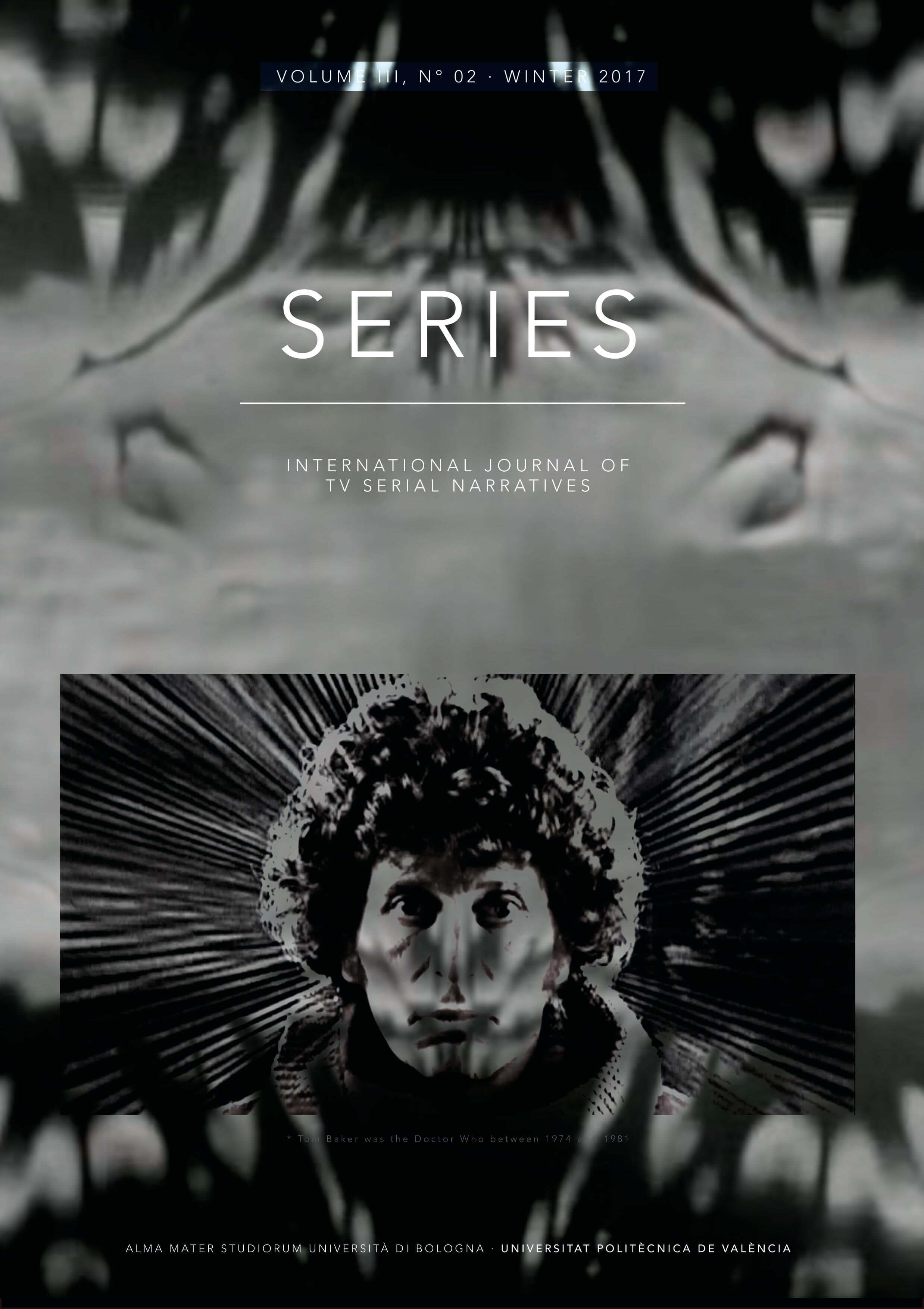Il disvelamento della politica in House of Cards. Un approccio sociosemiotico multimodale
DOI:
https://doi.org/10.6092/issn.2421-454X/7630Keywords:
House of Cards, socio-semiotic, frame, modality, direction of photography, color gradingAbstract
The paper analyzes the communication strategy of the 13th episode of the fourth season of House of Cards. This political drama offers viewers a communicative pact that underlies their social competence to distinguish among the different frames of realism, verisimilitude, sincere confidence, staged fiction, and/or public media representation. Because the episode’s meta message to its audience is that whatever is visible has been artfully constructed (both in private and public), the protagonist pedagogically invites the viewer to interpret the facts presented in the episode with cynicism. The themes and the characters are closely related to contemporary television news and political agendas (the events and protagonists of the 2016 US presidential election, foreign policy, the war against terrorism). The paper’s analytical approach is multimodal socio-semiotic: in it, I focus on the degree of realism ascribed to different frames (according to Goffman’s theory) and analyze the visual markers of photorealism. In particular, I investigate, with the help of digital tools, the conventions adopted in the direction of photography and color grading to differentiate frames and convey the story’s trustworthiness and the politicians’ dishonesty.References
Barisione, Mauro (2009). Comunicazione e società: teorie, processi, pratiche del framing. Bologna: il Mulino.
Berger, Peter L. and Thomas Luckmann (1966). The social construction of reality: a treatise in the sociology of knowledge. Garden City, NY: Anchor Books.
Bolter, Jay David and Richard Grusin (1999). Remediation: understanding new media. Cambridge (MA).: MIT Press.
Brighenti, Andrea Mubi (2010). Visibility in social theory and social research. New York: Palgrave Macmillan.
Cappella, Joseph and Kathleen Hall Jamieson (1997). Spiral of cynicism: The press and the public good. New York: Oxford University Press.
Casetti, Francesco e Federico Di Chio (2009). Analisi del film. Milano: Bompiani.
Demaria, Cristina (2015). “Political Dramas e drammi della politica in tempi di crisi. House of Cards e dintorni.” Between 5(10): 1-20. DOI: http://dx.doi.org/10.13125/2039-6597/1967.
Dobbs, Michael (2013). House of Cards. New York: Simon and Schuster.
Entman, Robert M (1993). “Framing: Toward clarification of a fractured paradigm.”. Journal of communication 43(4), 51-8.
Erdogan, B. Zafer (1999). “Celebrity Endorsement: A Literature Review.” Journal of Marketing Management 15(4): 291-314. DOI: 10.1362/026725799784870379.
Ernst, Douglas (2015). “Kevin Spacey: Bill Clinton said ‘House of Cards’ is ‘99 percent’ accurate.” http://www.washingtontimes.com/news/2015/mar/31/kevin-spacey-bill-clinton-said-99-percent-house-ca/. (last accessed 01-05.17).
Flewitt, Rosie, et al. (2009). “What are multimodal data and transcription?” In Routledge Handbook of Multimodal Analysis, edited by Carey Jewitt, 40-53. London: Routledge.
Frisina, Annalisa (2013). Ricerca visuale e trasformazioni socio-culturali. Torino: UTET.
Fritz, Alice J. Marianne (2015). “The West Wing and House of Cards: A Comparison of Narrative Strategies of Two Politically-themed Dramas.” Colloquy 11: 126-52.
Fumarola, Silvia (2014).“House of Cards, Kevin Spacey: ʻIl mio Underwood crudele come Riccardo III.ʼ. http://www.repubblica.it/spettacoli/tv-radio/2014/10/07/news/house_of_cards_kevin_spacey_robin_wright-97474593/ (last accessed 01-05-17).
Giglio, Ernest D. (2010). Here's looking at you: Hollywood, film & politics. New York: Peter Lang.
Greimas, Algirdas Julien e Joseph Courtés (2007). Semiotica: dizionario ragionato della teoria del linguaggio. Milano: Bruno Mondadori.
Goffman, Erving (1959). The presentation of self in everyday life. New York: Doubleday Anchor Books.
Goffman, Erving (1974). Frame Analysis: An Essay on the Organization of Experience. New York: Harper & Row.
Haas, Elizabeth, et al. (2015). Projecting politics: political messages in American films. New York: Routledge.
Hackett, J Edward (2015). House of Cards and Philosophy: Underwood's Republic. Chichester, UK: John Wiley & Sons.
Hodge, Robert and Gunther Kress (1988). Social semiotics. New York: Cornell University Press.
Holbert, R, Lance (2005). “A typology for the study of entertainment television and politics.”. American Behavioral Scientist 49(3): 436-53.
Kelle, Udo (2005). “Sociological Explanations between Micro and Macro and the Integration of Qualitative and Quantitative Methods.” Historical Social Research / Historische Sozialforschung 2(1): 95-117. DOI: http://dx.doi.org/10.17169/fqs-2.1.966.
Kress, Gunther R. (2010). Multimodality: a social semiotic approach to contemporary communication. London; New York: Routledge.
Kress, Gunther R. and Theo van Leeuwen (1996). Reading Images: The Grammar of Visual Design. London: Routledge.
Lewins, Ann and Christina Silver (2007). Using Software in Qualitative Research. London: Sage.
Lichter, S. Robert, et al. (2000). “Government goes down the tube: Images of government in TV entertainment, 1955-1998.” Harvard International Journal of Press/Politics 5(2): 96-103.
Lombardi, Anna (2016). “Trump, Clinton e House of Cards. Lo spettacolo della politica americana nelle case degli iraniani.” http://www.repubblica.it/esteri/2016/10/12/news/trump_clinton_e_house_of_cards_lo_spettacolo_della_politica_americana_nelle_case_degli_iraniani-149599830/ (last accessed 01-05-17).
Martinovic, Igor (2014). House of Cards (With Igor Martinovic) GCS025 http://gocreativeshow.com/house-of-cards-with-igor-martinovic-gcs025/) (last accessed 01-05-17).
Muybridge, Eadweard (2012). Animals in motion. New York: Dover Publications.
Pogliano, Andrea e Marco Solaroli (2016). “L’analisi dei frame visuali dell’informazione: il caso del fotogiornalismo sull’immigrazione in Italia.” Metodi visuali di ricerca sociale, a cura di Annalisa Frisina, 83-105). Bologna: il Mulino.
Spry, Amanda, et al. (2011). “Celebrity endorsement, brand credibility and brand equity.” European Journal of Marketing 45(6): 882-909. DOI: 10.1108/03090561111119958.
Torres, Ivan Abarca (2015). “Too Close for Comfort: the Political Telenovela El Candidato and the 2000 Mexican Presidential Election.”. SERIES-International Journal of TV Serial Narratives 1(1): 9-25. DOI: 10.6092/issn.2421-454X/5111.
Van Gorp, Baldwin (2010). “Strategies to take subjectivity out of framing analysis.” In Doing news framing analysis: Empirical and theoretical perspectives, edited by Paul D'angelo and Jim Kuypers, 84-109. New York: Routledge.
Van Leeuwen, Theo (2005). Introducing social semiotics. London; New York: Routledge.
Van Zoonen, Liesbet and Dominic Wring (2012). “Trends in political television fiction in the UK: Themes, characters and narratives, 1965–2009.” Media, Culture & Society 34(3): 263-79. DOI: 10.1177/0163443711433663.
Vliegenthart, Rens and Liesbet Van Zoonen (2011). “Power to the frame: Bringing sociology back to frame analysis.”. European Journal of Communication 26(2): 101-15. DOI: 10.1177/0267323111404838.
Downloads
Published
How to Cite
Issue
Section
License
Copyright (c) 2017 Paolo Parmeggiani
Copyrights and publishing rights of all the texts on this journal belong to the respective authors without restrictions.
This journal is licensed under a Creative Commons Attribution 4.0 International License (full legal code).
See also our Open Access Policy.





